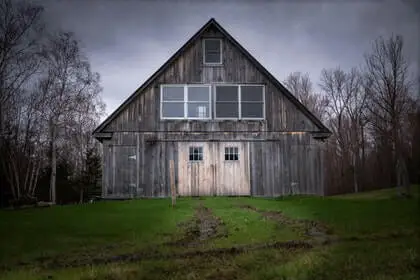Owning a pole barn in regions with extreme winter conditions is quite unbearable if you’ve got no heat insulation and heating it up could be quite tricky because of its natural feel. However, you shouldn’t be worried because there are a few cost-effective options you can adapt. They include using furnaces, wood stoves, heating machines that run on gas, and finally, radiant heating systems.
If you’re wondering what these are, I’ll be going into detail about them in this article. I’ll also discuss why they are the best options for your pole barn.
The Origin of Pole Barns
Pole barns have existed since the 1930s. The global recession resulted in US farmers searching for cheap options for building their barns. They began to use utility poles which they’ll bury deep into the ground as a foundation to support the roof. That’s how they got the name “pole barn”.
The construction of modern pole barns is quite similar to their original counterpart. However, they have additional steel poles and stronger columns that make them stronger and more versatile in their use. Often times when the words “pole barn” come to mind, we assume that it is an isolated farm building for storing farm animals or harvested produce but that’s not all they are used for. Some people use it as a workshop, stable, garage, man cave, or home.

For all these uses though, it is required that the barn have some heating system in place. The heating method is largely dependent on what you use your pole barn for and if it requires you to spend a lot of time in it.
So, here are the ways in which you can heat up a pole barn.
Furnaces
These heating systems either make use of propane, electricity or natural gas to heat up the barn. The air is heated in one spot before it is channeled throughout the barn through connected ducts and vents. It is a forced warm air distribution system that is often called the ducted warm air system.
The combusted gases are usually expelled using the vents. Once the furnace is ignited, heat is transferred to the incoming air via the heat exchanger. The air is then propelled by the furnace blower through the ducts to distribute it throughout the uninsulated pole barn.
Using a propane heater has its own benefits. They include being odorless, a quality that will be greatly appreciated because they need well-ventilated rooms to enjoy them. They are easy to place and are also very powerful.
This heating solution is perfect for man caves, garages, pole barns being used as homes, and workshops.
Wood and Pellet Stoves
For rural farms burning some wood is the best option. It is highly cost-effective because it is cheaper to burn wood than it is to burn gas. However, it is not sustainable for the environment because the CO2 emissions pollute the atmosphere.
To use them, there are certain requirements stipulated by EPA, the United States Environmental Protection Agency. These requirements ensure that burning wood in stoves will still yield a better air quality for its users.
If you’d rather not deal with the requirements, an alternative to wood will be pellets. Pellets are considerably more expensive and they happen to be a cleaner fuel when compared to wood. They are made from both softwood and hardwood, and their benefits are endless. From their better temperature control to their better air quality, to the greater amount of heat they generate.
To really get into detail about how they operate, you should know that they have a combustion blower. This is responsible for bringing outside air into the stove through the allocated air vents and releasing smoke through the exhaust vent. Thereafter, you can opt for the distribution of heat throughout the barn using some heat-exchange tubes or you could let the heating process occur naturally. Either way is fine.
A fun fact to note is that, according to American Energy Systems, pellet stoves are more effective than electricity or propane run heaters. The ideal place to use the wood or pellet stove is in pole barns that are used as a workshop or man cave.
Radiant/Infrared Heaters
These are perfectly suited for drafty uninsulated pole barns that don’t need to be heated entirely and here’s how they work. They direct heat to a specific area in the barn and work similarly to sun rays. What’s more, they can be redirected to focus on a different area that requires heating.
Because of the draft, the heated air is circulated naturally. They either run on gas or electricity. Finally, they are perfect for stables, man caves, garages, and workshops.

Our Heating Recommendations
So, if you aren’t eager to work in a cold pole barn, here are our superb recommendations.
Modine Natural Gas Garage Heater: This heater comes highly recommended because it is a powerful odorless option that operates quietly. This makes it perfect for a pole barn home or a man cave. It is quick to install because of its easy wiring connections. It also has knockouts for quick access to electricity or gas. It has a small diameter vent making the venting system easier be it via roof or sidewall. It comes in very handy during blackouts.
Wiseway Non-Electric Pellet Stove: This pellet stove is EPA certified, silent in operation, and can heat about 2000 square feet of a pole barn. What’s more, it can hold up a large number of pellets for about thirty hours. This means that there’ll be fewer trips to fill it up with pellets.
LifeSmart Infrared Heater: This energy-efficient heating option is ideal for large rooms. It comes with an air filter and you can rest assured that the air in your barn won’t be dry. It’s also energy-saving and has a remote-controlled digital thermostat. Also, you can be sure that while it’s in operation your room remains warm and you can heat up specific objects within the barn. The heat generated doesn’t disappear when cold winds blow.
You should definitely avoid kerosene heaters because they are just too expensive and can hardly be called a clean energy source.
Frequently Asked Questions (FAQs)
Here are some common questions people ask before buying a heating system. Hopefully, these might help with your decision-making.
What heater size should I buy for my pole barn?
The recommended heater size for your pole barn is largely dependent on the size of your barn and its room temperature without heating. Large size and low temperature mean that you require a high-powered heating system. Check the heaters available in the store. Notice that they have BTU ratings. BTU stands for British thermal units and is used to demonstrate how much heat will be used to burn a given volume of water.
Are propane heaters save the most amount of fuel?
Yes, they do. It’s been declared that they provide more heat per fuel unit.
Are infrared heaters suitable for large pole barns?
It depends on the function that it serves. If you want to use it to heat up a certain item or location in the barn, then it is perfect.
However, if you’d like to heat up the whole barn, it is unsuitable.
Hopefully, this guide has taught me a thing or two about the measures to be taken when heating up an uninsulated workbench. A proper ventilation network is a key to an effectively insulated barn.




